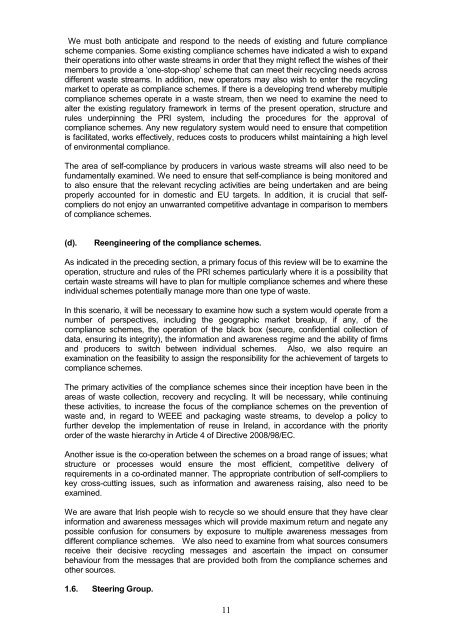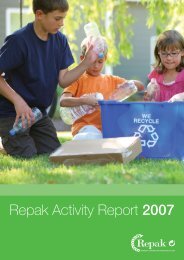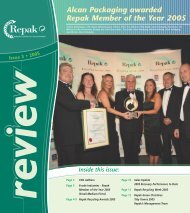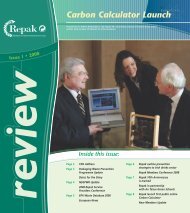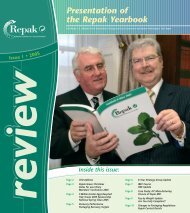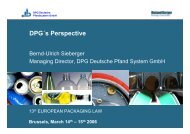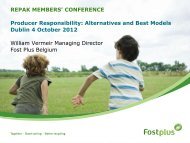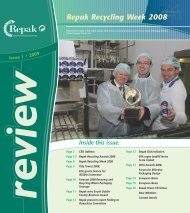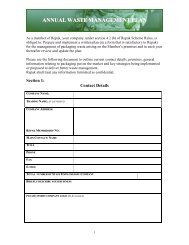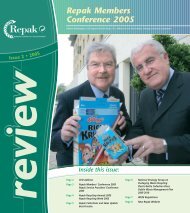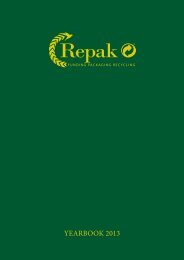Review Of The Producer Responsibility Initiative Model In ... - Repak
Review Of The Producer Responsibility Initiative Model In ... - Repak
Review Of The Producer Responsibility Initiative Model In ... - Repak
You also want an ePaper? Increase the reach of your titles
YUMPU automatically turns print PDFs into web optimized ePapers that Google loves.
We must both anticipate and respond to the needs of existing and future compliance<br />
scheme companies. Some existing compliance schemes have indicated a wish to expand<br />
their operations into other waste streams in order that they might reflect the wishes of their<br />
members to provide a ‘one-stop-shop’ scheme that can meet their recycling needs across<br />
different waste streams. <strong>In</strong> addition, new operators may also wish to enter the recycling<br />
market to operate as compliance schemes. If there is a developing trend whereby multiple<br />
compliance schemes operate in a waste stream, then we need to examine the need to<br />
alter the existing regulatory framework in terms of the present operation, structure and<br />
rules underpinning the PRI system, including the procedures for the approval of<br />
compliance schemes. Any new regulatory system would need to ensure that competition<br />
is facilitated, works effectively, reduces costs to producers whilst maintaining a high level<br />
of environmental compliance.<br />
<strong>The</strong> area of self-compliance by producers in various waste streams will also need to be<br />
fundamentally examined. We need to ensure that self-compliance is being monitored and<br />
to also ensure that the relevant recycling activities are being undertaken and are being<br />
properly accounted for in domestic and EU targets. <strong>In</strong> addition, it is crucial that selfcompliers<br />
do not enjoy an unwarranted competitive advantage in comparison to members<br />
of compliance schemes.<br />
(d).<br />
Reengineering of the compliance schemes.<br />
As indicated in the preceding section, a primary focus of this review will be to examine the<br />
operation, structure and rules of the PRI schemes particularly where it is a possibility that<br />
certain waste streams will have to plan for multiple compliance schemes and where these<br />
individual schemes potentially manage more than one type of waste.<br />
<strong>In</strong> this scenario, it will be necessary to examine how such a system would operate from a<br />
number of perspectives, including the geographic market breakup, if any, of the<br />
compliance schemes, the operation of the black box (secure, confidential collection of<br />
data, ensuring its integrity), the information and awareness regime and the ability of firms<br />
and producers to switch between individual schemes. Also, we also require an<br />
examination on the feasibility to assign the responsibility for the achievement of targets to<br />
compliance schemes.<br />
<strong>The</strong> primary activities of the compliance schemes since their inception have been in the<br />
areas of waste collection, recovery and recycling. It will be necessary, while continuing<br />
these activities, to increase the focus of the compliance schemes on the prevention of<br />
waste and, in regard to WEEE and packaging waste streams, to develop a policy to<br />
further develop the implementation of reuse in Ireland, in accordance with the priority<br />
order of the waste hierarchy in Article 4 of Directive 2008/98/EC.<br />
Another issue is the co-operation between the schemes on a broad range of issues; what<br />
structure or processes would ensure the most efficient, competitive delivery of<br />
requirements in a co-ordinated manner. <strong>The</strong> appropriate contribution of self-compliers to<br />
key cross-cutting issues, such as information and awareness raising, also need to be<br />
examined.<br />
We are aware that Irish people wish to recycle so we should ensure that they have clear<br />
information and awareness messages which will provide maximum return and negate any<br />
possible confusion for consumers by exposure to multiple awareness messages from<br />
different compliance schemes. We also need to examine from what sources consumers<br />
receive their decisive recycling messages and ascertain the impact on consumer<br />
behaviour from the messages that are provided both from the compliance schemes and<br />
other sources.<br />
1.6. Steering Group.<br />
11


